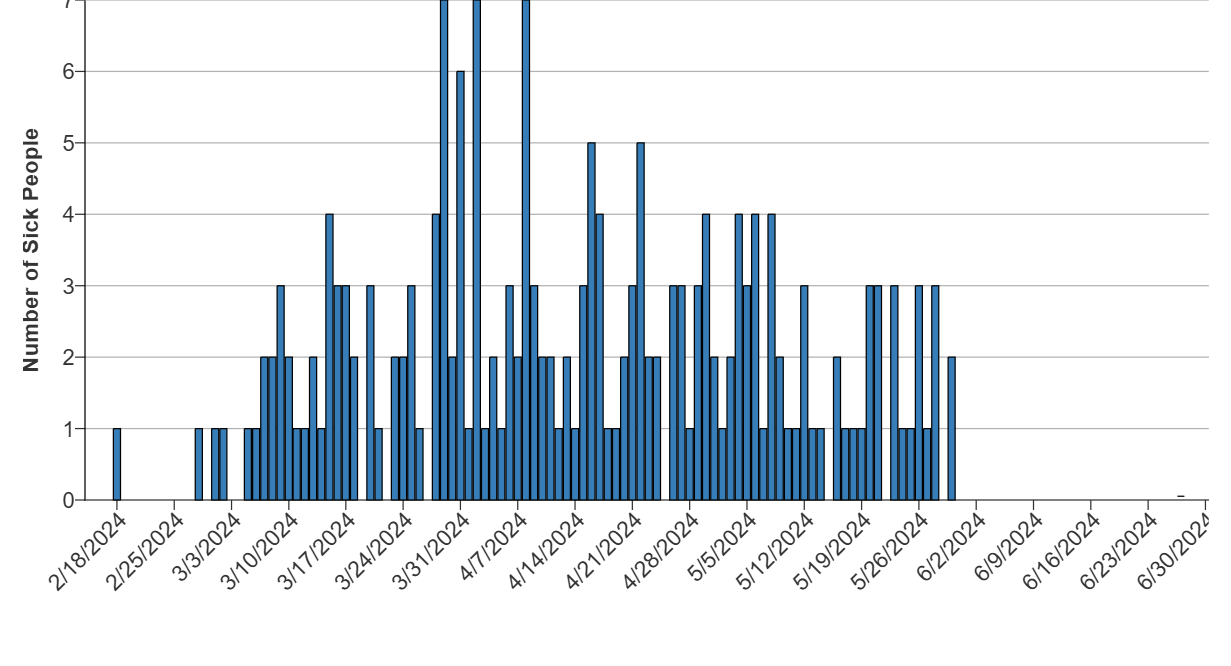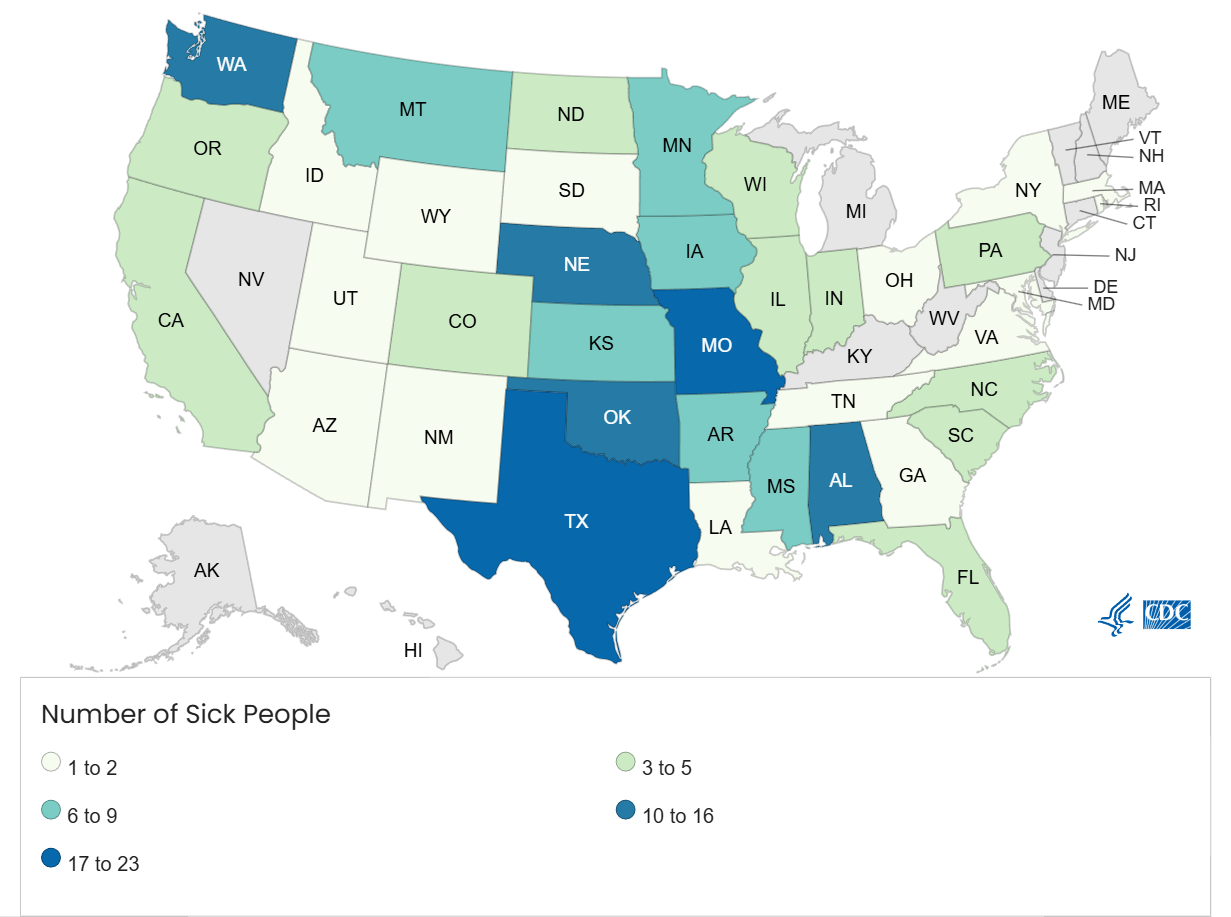2024 Food Recalls
We’re a little more than halfway through the year and as August begins, Summer is dwindling, and the Back-to-School season is starting.
On June 25, 2024 the CDC reported an update to the multi-state outbreak of 7 Salmonella strains, which began in the United States in February 2024.
The report states, “epidemiologic, laboratory, and traceback data show that contact with backyard poultry is making people sick (www.cdc.com).” Backyard poultry is defined as duck, geese, chicken, guinea fowl, and turkey according to the Healthy Pets, Healthy People section of their website.
Below is a list of diseases backyard poultry can spread. To learn more about each disease please click their name:
· Bird flu
(www.cdc.com)
Right now, the number of people affected by this outbreak is likely higher than what the data reports. They go on to say, this is because it normally takes 3-4 weeks to determine if an illness is a part of the outbreak, many people are not tested for the bacteria, and/ or because of those who recover without medical treatment (www.cdc.com).” The CDC traceback data reports, “people reported purchasing poultry from multiple retail stores or directly from a hatchery. Multiple hatcheries supplied birds to the retail stores ( www.CDC.com).”
The 7 types of Salmonella quickly spreading across the country are:
Salmonella Altona
Salmonella Cerro
Salmonella Indiana
Salmonella Indiana
Salmonella Infantis
Salmonella Johannesburg,
Salmonella Mbandaka
Salmonella Typhimurium
The chart below shows how many people have been affected since the outbreak began:
When People Got Sick
Source: CDC
Number of Sick People
Source: CDC
Scientists who study whole genome sequencing have studied the bacteria and found “ bacteria from 176 people’s samples and 13 environmental samples had no predicted resistance; 14 people’s samples predicted resistance to one or more of the following antibiotics: amoxicillin-clavulanic acid, ampicillin, cefoxitin, ceftiofur, ceftriaxone, chloramphenicol, ciprofloxacin, gentamicin, kanamycin, streptomycin, sulfisoxazole, and tetracycline (www.CDC.com).” However, “most people with Salmonella illness recover without antibiotics. However, if antibiotics are needed, some illnesses in this outbreak may be difficult to treat with some commonly recommended antibiotics and may require a different antibiotic choice ( www.cdc.com).”
So what is Salmonella?
Salmonella is a group of bacteria that lives in the intestines of domesticated farm animals, pets, and some humans. It becomes dangerous to humans when we ingest or are exposed to it directly or indirectly from exposure to the carrier animals and in some cases by others who are infected. While most strains of Salmonella are specific to animals. Salmonella Typhi, not to be confused with Salmonella Typhimurium, is specific to humans.
The bacteria group causes two types of infections: typhoidal and non-typhoidal. Symptoms of severe food poisoning, stomachache, rash, loss of appetite, high fever, gastrointestinal infection and bleeding, urinary tract, and brain infection are typical with typhoidal infection and can occur 1-10 days after exposure.
Along with vomiting, the same symptoms can occur in non-typhoidal infections, which can show symptoms within 2-7 days of exposure. If infected, a person is contagious 6-72 hours after exposure to the bacteria.
The young, elderly, pregnant, and immunocompromised are at risk for these types of infections.
Copyright © 2024 People’s Medicine Wellness
How to prevent and recover from Salmonella exposure and poisoning.
Unfortunately, salmonella contamination can happen to anyone. It can happen at your favorite restaurant, in your home kitchen, and whether you eat meat or vegetables.
So, you’re probably thinking, “what can I do to keep me and my family safe”?
First, consider hygiene. AVOID restaurants, food trucks, and stores where employees and restaurants/kitchens look unclean or sick. Home-cooked food is better anyway!!!
Next, when preparing food at home avoid cross-contamination with raw foods like eggs, meat, seafood, and produce. Salmonella is commonly found in run-off water, soil, and on items exposed to contaminated animal waste or fluids. To stay safe, wash your hands (or change gloves) frequently when handling different foods and before you touch a new surface. Also, use a different cutting board and clean your prep environment when moving from raw foods to produce or cooked food. Never prepare cooked or prepared food on a surface that is still dirty from handling a raw food item.
For example, for dinner, you prepare a steak, salad, and baked potato. You use a cutting board to score the beef before you place it on the grill. Next, you place the recently washed lettuce on the same cutting board you used to score the beef. NEVER do this! That cutting board was exposed to raw meat. By placing the lettuce on the same cutting board before washing and sanitizing it properly, the lettuce has now been cross-contaminated.
Also, avoid eating raw foods like raw eggs, raw fish (sushi), and undercooked meats. Meat, cooked dishes, and seafood need to be cooked to an internal temperature of 145-165 ° F.
For more on the safe cooking temperatures of foods please visit, Cook to a Safe Minimum Internal Temperature | FoodSafety.gov
Also, consider your health. Food handling is one thing, but if your immunity is poor, you will increase your chances of getting sick from harmful bacterial exposure. To increase your immunity, stay away from people who are constantly sick. Increase your intake of fresh fruits and vegetables DAILY and eat them multiple times a day. Eliminate SUGAR and alcohol! Eliminating sugar, sweeteners, and alcohol - even if it’s from a natural source. Being disciplined about this helps rebuild your digestive and immune system faster than consuming a “small amount, every now and then”. Your body's immunity will rebound much faster, making it easier to defend itself from invaders.
To learn more about microbial resistance, please visit:
Antibiotic Resistance and NARMS Surveillance | NARMS | CDC
To learn more on how to stay healthy around backyard poultry, please visit:
Backyard Poultry | Healthy Pets, Healthy People | CDC
If you’d like to learn more about how to keep your family healthy click here to schedule a discovery call with a nutrition consultant.
Love and Green Leaves
Trina
Sources:
Investigation Details | Salmonella Outbreaks Linked to Backyard Poultry | CDC
Antibiotic Resistance and NARMS Surveillance | NARMS | CDC
Cook to a Safe Minimum Internal Temperature | FoodSafety.gov




